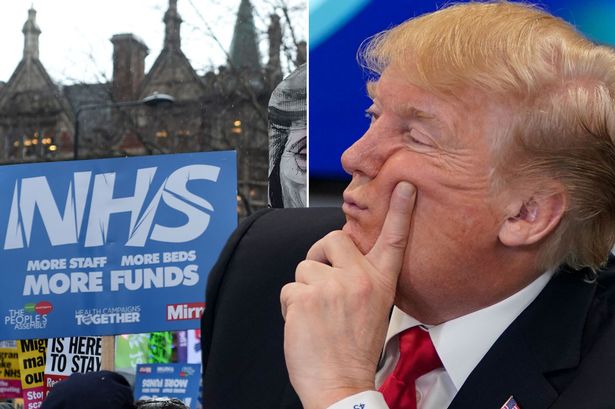Health
NHS Faces Funding Crisis Amid Threats of Higher Drug Prices

NHS leaders have issued a stark warning to the UK government: without addressing a potential funding shortfall of up to £3 billion, patients will face longer wait times for essential care. The warning comes as former US President Donald Trump threatens to impose higher drug prices, which could exacerbate the NHS’s financial challenges.
The NHS Confederation and NHS Providers, which represent various health organizations and trusts, have highlighted the implications of inflated drug costs. They stated that the current budget does not account for the financial impact of increased medicine prices or the costs associated with redundancies and strikes. This situation poses a severe risk to the ongoing recovery of the NHS, particularly as government officials negotiate a trade deal with the United States that may impose billions in additional costs for pharmaceuticals.
The proposed agreement could elevate the drug “value for money” threshold by 25%, potentially creating a substantial budget deficit for the NHS. Matthew Taylor, chief executive of the NHS Confederation, emphasized, “The threat from un-budgeted redundancy payments, higher drug prices, and renewed industrial action risks derailing progress on key waiting time targets and the wider reforms that are essential to getting the NHS back on track.”
As it stands, NHS leaders predict that a deal with the US could cost the organization approximately £1.5 billion this year alone. This figure could be compounded by an additional £1 billion required for redundancy payments stemming from the government’s decision to merge NHS England back into the Department of Health and Social Care. The cumulative effect of these costs may lead to a funding gap of up to £3 billion, significantly affecting patient care and treatment timelines.
Concerns are mounting among NHS leaders about the possibility of rationing certain services, such as in vitro fertilization (IVF). One anonymous NHS trust chief executive explained that when funds are limited, operational changes—like reducing weekend theatre availability or limiting additional operating lists—are often the first measures taken. “These are the easiest things to stop when money is tight, but they have an immediate impact on waiting times,” they remarked.
The UK Chancellor, Rachel Reeves, is expected to present the autumn budget on November 26, 2024, with ongoing discussions between Health Secretary Wes Streeting and the Treasury regarding the NHS’s financial needs. A spokesperson for the Department of Health and Social Care reiterated the government’s commitment to the NHS, stating, “This government has delivered a record-breaking £29 billion investment in our NHS, demonstrating our unwavering commitment to properly funding the health service that we all rely on.”
Despite the investment, NHS acute hospital trusts in England reported a 5.8% increase in activity between 2024 and 2025. However, costs also rose by 3%, resulting in an overall productivity increase of only 2.7%. The NHS is grappling with a backlog that has stalled since the Labour Party came to power in 2024, with the total waiting list for routine hospital treatments increasing by nearly 12,000 in August, now reaching 7.41 million.
When the Labour Party took office, the NHS waiting list stood at 7.6 million, having climbed steadily from 2.5 million since 2010. The new government initially made progress, reducing the backlog by 220,000 in its first year. However, NHS leaders now express concern that financial restrictions and unanticipated costs will jeopardize these advances.
Both Matthew Taylor and Daniel Elkeles, chief executive of NHS Providers, urged for a realistic assessment of what can be achieved under the current financial constraints. Taylor remarked, “NHS leaders are playing their part by delivering record levels of activity and the highest productivity improvements seen in years.” Yet, he noted that leaders face limitations without the necessary upfront funding to manage redundancies that could ultimately save taxpayer money in the long run.
Elkeles added, “This isn’t where we want to be. NHS trusts are doing all they can to make big savings and boost productivity. But redundancies cost money, making it harder to make long-term savings without government support.”
As the government prepares for its budget announcement, it must confront the reality of the NHS’s financial landscape and its implications for patient care in the coming year.
-

 Health2 months ago
Health2 months agoNeurologist Warns Excessive Use of Supplements Can Harm Brain
-

 Health2 months ago
Health2 months agoFiona Phillips’ Husband Shares Heartfelt Update on Her Alzheimer’s Journey
-

 Science1 week ago
Science1 week agoBrian Cox Addresses Claims of Alien Probe in 3I/ATLAS Discovery
-

 Science6 days ago
Science6 days agoNASA Investigates Unusual Comet 3I/ATLAS; New Findings Emerge
-

 Science3 days ago
Science3 days agoScientists Examine 3I/ATLAS: Alien Artifact or Cosmic Oddity?
-

 Entertainment3 months ago
Entertainment3 months agoKerry Katona Discusses Future Baby Plans and Brian McFadden’s Wedding
-

 World2 months ago
World2 months agoCole Palmer’s Cryptic Message to Kobbie Mainoo Following Loan Talks
-

 Entertainment3 months ago
Entertainment3 months agoEmmerdale Faces Tension as Dylan and April’s Lives Hang in the Balance
-

 Entertainment3 months ago
Entertainment3 months agoLove Island Star Toni Laite’s Mother Expresses Disappointment Over Coupling Decision
-

 Entertainment2 months ago
Entertainment2 months agoMajor Cast Changes at Coronation Street: Exits and Returns in 2025
-

 World2 months ago
World2 months agoCoronation Street’s Asha Alahan Faces Heartbreaking Assault
-

 Entertainment2 weeks ago
Entertainment2 weeks agoStefan Dennis and Dianne Buswell Share Health Update on Strictly Come Dancing









